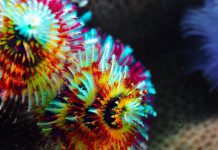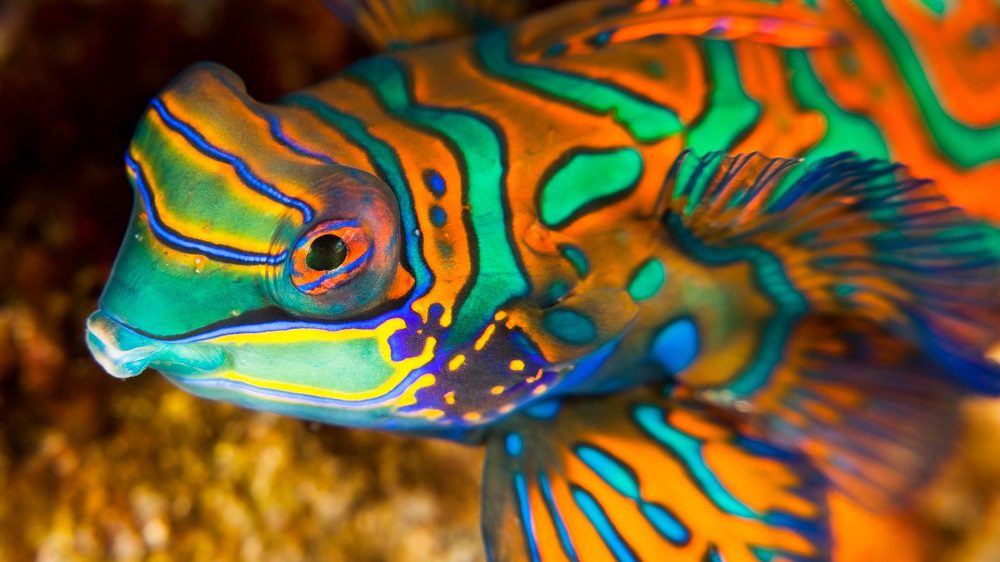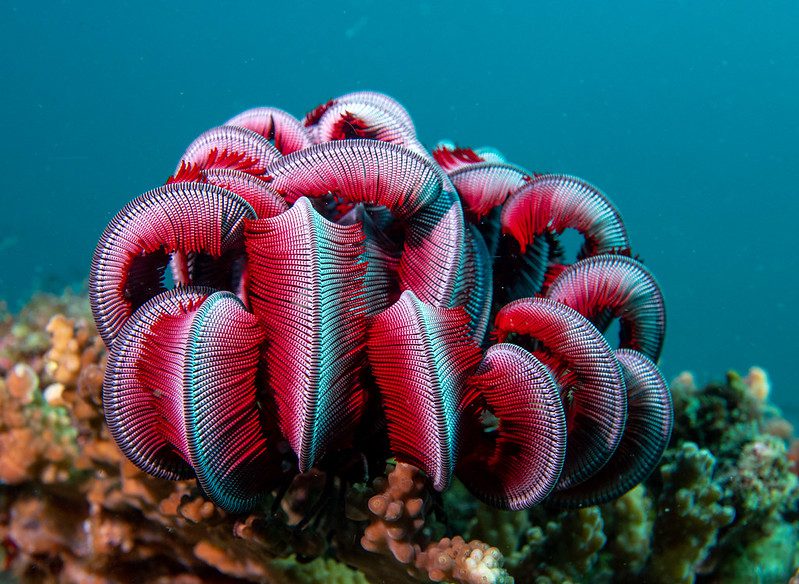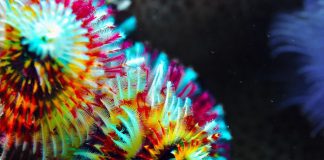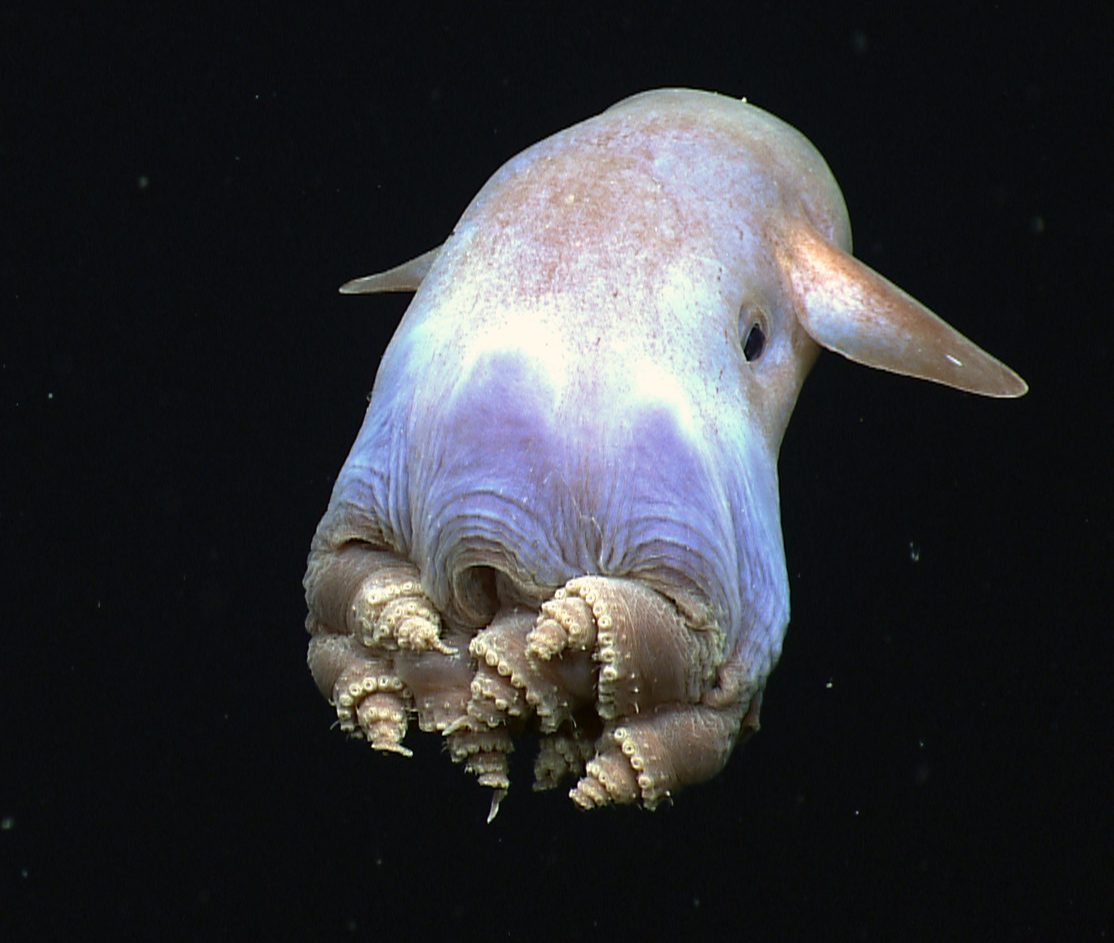
Scientific classification
- Kingdom: Animalia
- Phylum: Mollusca
- Class: Cephalopoda
- Order: Octopoda
- Family: Opisthoteuthidae
- Genus: Grimpoteuthis
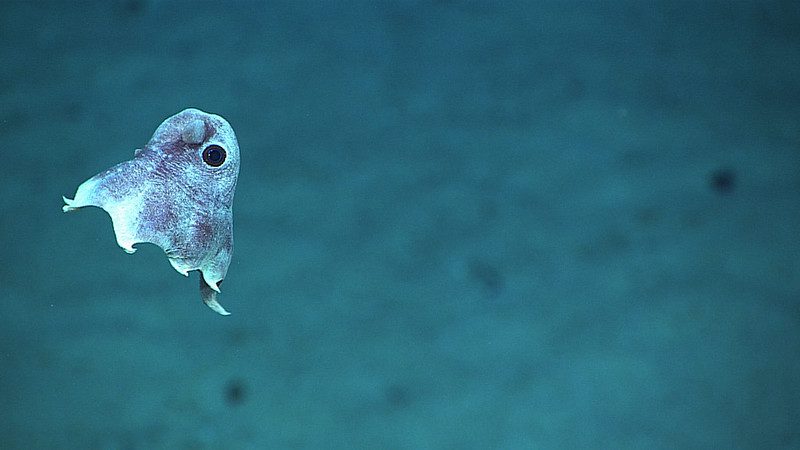
The Adaptations of a Dumbo Octopus
Dumbo Octopuses have several adaptations that enable them to survive in their deep-sea habitat:
- Ear-like fins: Dumbo Octopuses have a pair of ear-like fins on the top of their head, which are used for propulsion and maneuverability.
- Camouflage: Dumbo Octopuses can change color to blend in with their surroundings, making it difficult for predators to spot them.
- Jet propulsion: Dumbo Octopuses can move quickly through the water using jet propulsion, which allows them to escape predators and catch prey.
- Tentacles: Dumbo Octopuses have eight arms and two tentacles, which they use to catch prey and manipulate objects.
- Resilience: Dumbo Octopuses are known to be very resilient creatures and can survive in extreme conditions.
- Small size: Dumbo Octopuses are small creatures, which allows them to hide in small spaces and avoid predators.
- Reproduction: Dumbo Octopuses are known to lay eggs in clusters, which can number in the thousands. This ensures the survival of their species.
- Solitary creatures: Dumbo Octopuses are not typically found in groups, which reduces competition for food and mating opportunities.
- Deep-sea creatures: Dumbo Octopuses are considered to be deep-sea creatures, which means they can live in areas where the pressure, temperature, and light levels are different than the surface.
When it comes to the fascinating world of deep-sea creatures, dumbo octopus behavior stands out as particularly intriguing. These adorable cephalopods, known scientifically as Grimpoteuthis species, exhibit unique characteristics and behaviors that have captured the attention of researchers and nature lovers alike.
In this blog post, we will delve into the captivating actions of these umbrella octopuses as they navigate their extreme depths. You’ll learn about their distinctive physical features and how they employ a combination of swimming techniques to move gracefully through the ocean’s abyss.
Furthermore, we will explore how Nautilus Live has allowed us to observe dumbo octopus behavior in real time by providing valuable insights into their biology, geology, and archaeology. Ultimately, you’ll gain an understanding of the unique habits that set these mysterious animals apart from other denizens of our deep seas.
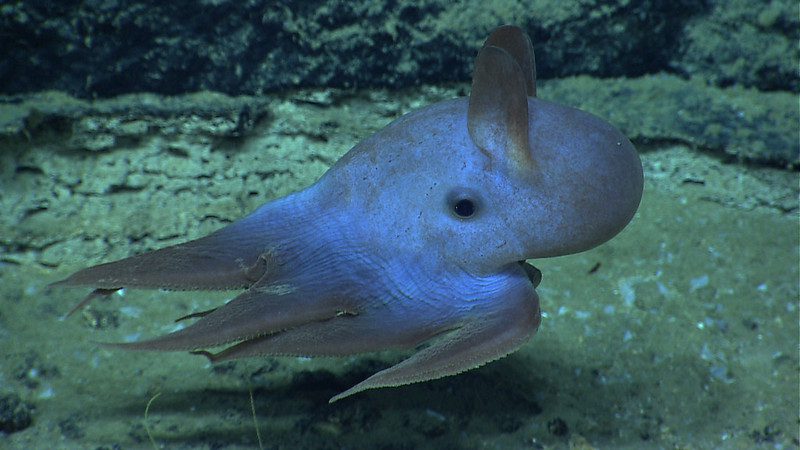
What is a Dumbo Octopus?
If you’re a fan of the Disney movie “Dumbo,” then you might be surprised to learn that there’s an octopus species named after the flying elephant. The dumbo octopus, also known as the umbrella octopus, are fascinating creatures that live in extreme depths of the ocean floor.
Dumbo Octopus Species
There are at least thirteen different species of dumbo octopuses, all belonging to the genus Grimpoteuthis. These creatures can vary in size and coloration depending on their specific species.
Largest Dumbo Octopus
The largest known dumbo octopus was found off the coast of California and measured around six feet long with arms outstretched! This particular specimen belonged to the Grimpoteuthis Megaptera species which has been observed up close by researchers only once before!
Distinguishing Features
- Their ear-like fins: The most notable feature of these creatures is their two large fins resembling ears which they use for movement through the water.
- Ink sacs: They have ink sacs like other cephalopods, but it is not used for defense purposes rather than producing light flashes or blinding predators so they can escape from them easily.
- Bristle worms diet: They feed mostly on bristle worms along with small crustaceans such as amphipods and copepod larvae.
- Egg-laying habits: Unlike other types of cephalopods who lay eggs only once per season, female dumbo octopuses continuously lay eggs throughout their lifetime.
Deep-Sea Dwellers
Dumbo octopuses live in the deepest parts of the ocean floor, where they are safe from large predators. They can be found at depths ranging from 300 to over 23,000 feet below sea level! These creatures have adapted to their extreme environment and have developed unique features such as transparent skin that helps them blend into their surroundings.
Young Octopuses
When dumbo octopus young hatch, they resemble miniature versions of adults and start feeding on small crustaceans almost immediately after hatching. The larvae float near the surface for a few weeks before settling down on the seafloor.
Fun Facts about Dumbo Octopuses:
- Their name comes from Disney’s “Dumbo” because of their ear-like fins, which resemble those of an elephant!
- Their big ears aren’t just for show – these fins help them move through water with ease.
- Dumbo octopuses are not commonly seen by humans due to their deep-sea habitat but scientists continue to learn more about them every day!
If you’re interested in learning more about other fascinating creatures that live in our oceans, check out some great resources like the National Geographic or Ocean Conservancy websites.
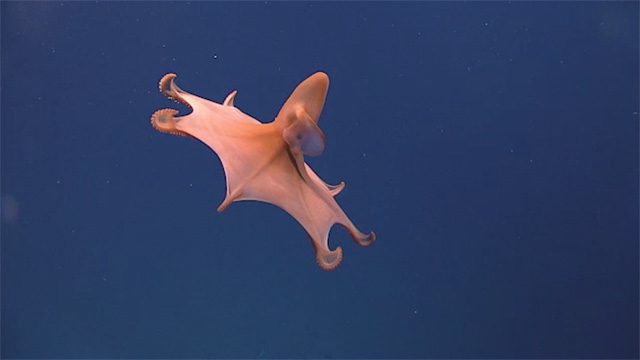
Dumbo Octopus Reproduction
Dumbo octopuses, also known as umbrella octopuses, are fascinating creatures that live in the deep sea. These animals belong to the Grimpoteuthis species and have ear-like fins that resemble Dumbo’s big ears from the Disney movie.
Continuous Egg-Laying Process
Unlike other octopus species, dumbo octopuses continuously lay eggs throughout their lifetime. They don’t have a specific breeding season like most animals do. Instead, they reproduce year-round.
Deep Sea Environment Challenges
Living in extreme depths of up to several thousand meters below sea level is challenging for any creature. For dumbo octopuses, it means finding ways to protect their young from large predators while laying eggs on the ocean floor.
- Dumbo octopuses produce ink sacs similar to other cephalopods such as squids and cuttlefish; this serves as an escape mechanism when threatened by predators.
- Their diet consists mainly of bristle worms and small crustaceans found on or near the seafloor.
- Due to the low oxygen levels in their habitat, dumbo octopuses have a slower metabolism than other cephalopods. They also grow at a much slower rate and live longer.
In conclusion, dumbo octopuses are unique creatures that continuously lay eggs throughout their lifetime. Their deep-sea environment poses challenges for reproduction, but they have adapted well by producing ink sacs as an escape mechanism and feeding on small crustaceans found on or near the seafloor.
Where do Dumbo Octopuses Live?
Dumbo octopuses are fascinating creatures that belong to the Grimpoteuthis species. They get their name from their resemblance to Disney’s flying elephant, Dumbo, due to their ear-like fins.
Habitat of Dumbo Octopuses
These creatures live in extreme depths of the ocean floor and can be found worldwide in all oceans. They typically reside at a depth between 3000 and 4000 meters below sea level, making them one of the deepest-living octopus species on Earth.
- Dumbo octopuses prefer living in soft muddy bottoms or areas with volcanic activity where they can find food, such as bristle worms and other small crustaceans.
- Their large ears help them detect predators like sharks, while their ink sacs act as a defense mechanism against these big predators.
- In addition, dumbo octopuses continuously lay eggs throughout their lifetime which hatch into young octopuses known as “paralarvae.” These paralarvae then drift along with currents until they mature into adults.
Umbrella Octopus vs. Dumbo Octopus
Dumbo octopuses are often confused with umbrella octopuses because of similar features such as transparency, but both species have different habitats despite belonging to the same family group (Opisthotheusidae).
- Differences between Umbrella & Dumbo Octopuses:
- Dumbo octopuses are larger than umbrella octopuses.
- Dumbo octopuses have fins that resemble ears, while umbrella octopuses have webbed arms.
In conclusion, dumbo octopuses are fascinating creatures that live in the deep sea and possess unique features such as their ear-like fins. Their habitat preference differs from other species of octopus, like the umbrella octopus, despite belonging to the same family group.
Dumbo Octopus Behavior
Dumbo octopuses, also known as umbrella octopuses, are fascinating creatures that live in the deep sea. They get their name from their resemblance to the flying elephant in Disney’s movie “Dumbo” due to their ear-like fins.
The Largest Dumbo Octopus Species
There are at least thirteen species of dumbo octopuses, and they vary in size. The largest species is called Grimpoteuthis Megaptera and can grow up to six feet long! This impressive creature lives at extreme depths of up to 23,000 feet on the ocean floor.
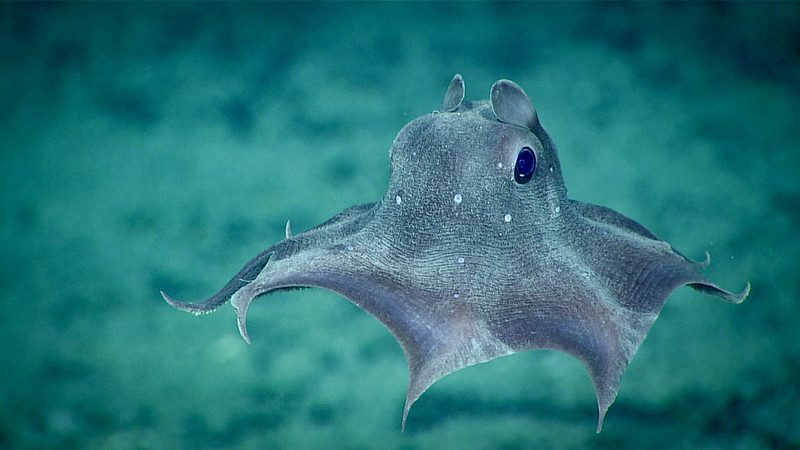
Young Octopuses
During mating season, female dumbo octopuses continuously lay eggs until they die. Once hatched, young octopuses look like miniature versions of adults but have translucent bodies.
The Deepest-Living Octopus
- Grimpoteuthis abyssicola: This is one of the deepest-living animals ever discovered; it was found living near hydrothermal vents over three miles below sea level!
More Fun Facts about Dumbo Octopuses
- Dumbo octopuses have an ink sac like other octopus species, which they use to deter predators.
- Their diet consists of bristle worms and other small creatures that live on the sea floor.
- Unlike most octopuses, dumbo octopuses don’t squirt ink in a cloud; instead, they release it as a sticky string to entangle their prey.
In conclusion, dumbo octopuses are unique and fascinating creatures with many interesting facts. They are truly remarkable animals that continue to amaze us with their abilities to survive in extreme environments!
Are Dumbo Octopuses an Endangered Species?
Dumbo octopuses are fascinating creatures that live in the deep sea. They are named after their resemblance to Disney’s flying elephant, Dumbo, due to their ear-like fins. These creatures belong to the Grimpoteuthis species and are umbrella octopuses.
Endangered Status
Due to living in remote areas far away from humans’ reach, little information is available regarding the population sizes of these unique creatures. However, according to the IUCN Red List criteria for assessing endangered status based on habitat degradation and overfishing, the Dumbo octopus is not currently considered endangered.
In conclusion, while there is still much to learn about these fascinating creatures that live in the extreme depths of our oceans, they are not currently classified as an endangered species.
The Intelligence of Dumbo Octopuses
Despite living in such harsh conditions, dumbo octopuses have proven themselves to be quite intelligent creatures. In fact, recent studies have shown that they can solve puzzles!
In one study conducted by marine biologists, a young dumbo octopus was placed inside a container with several holes drilled into it. The goal was for the octopus to figure out how to escape through one of the holes. After some trial and error, the octopus successfully escaped through one of the holes.
Can They Solve Puzzles?
Octopuses are known to be intelligent creatures, capable of solving puzzles and completing complex tasks.
Dumbo Octopuses are no exception and have been observed showing problem-solving skills and adapting to new environments.
They have been seen opening jars to obtain food, escaping from enclosures, and navigating mazes. They have also been observed using tools to obtain food, such as using coconut shells to hide from predators.
While Dumbo Octopuses have not been specifically studied for their problem-solving abilities, they likely possess a similar level of intelligence as other octopus species.
The Reproduction Habits of Dumbo Octopuses
In addition to their intelligence, dumbo octopuses are also interesting creatures when it comes to reproduction. Unlike most other octopus species that lay eggs once and then die, female dumbo octopuses continuously lay eggs throughout their lives.
Additionally, they have a unique way of protecting their young. When threatened by predators such as bristle worms or other deep-sea creatures, the mother will release an ink sac from her mantle cavity to distract the predator while she swims away with her young.
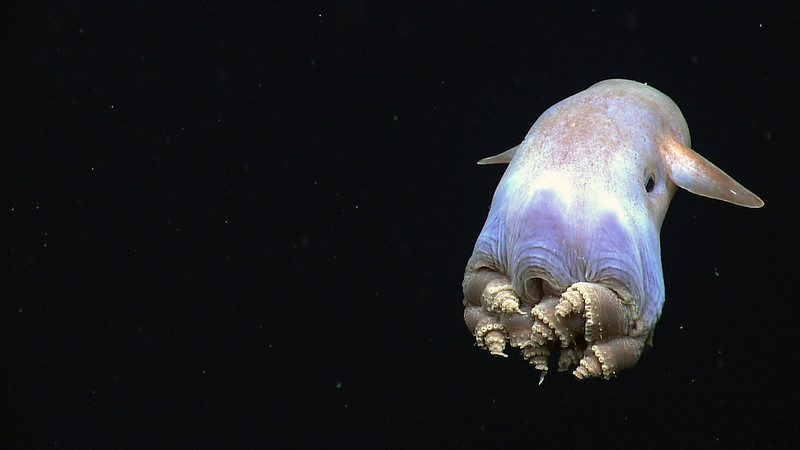
Different Species of Dumbo Octopuses
There are several different species within the Grimpoteuthis family – which is home to all types of umbrella and dumbo octopuses – each with its own unique characteristics and habits.
Dumbo Octopus in Action
The dumbo octopus is a fascinating creature known for its unique appearance and behavior. These finned octopods get their nickname from the Disney character, Dumbo, due to the ear-like fins on either side of their heads. This blog post will explore how these creatures move and interact with their environment while observing them through Nautilus Live’s underwater footage.
Physical Characteristics of the Dumbo Octopus
Belonging to the genus Grimpoteuthis, dumbo octopuses are characterized by the distinctive features that set them apart from other cephalopods. They have soft bodies covered in gelatinous skin, which helps them survive at great depths within our oceans where pressure can be immense. Their most notable feature is undoubtedly their large fins resembling elephant ears that they use for swimming.
- Size: Typically ranging between 20-30 centimeters (7-12 inches) long, but some species can grow up to 60 centimeters (24 inches).
- Fins: Large ear-like fins used for propulsion and steering during swimming.
- Tentacles: Eight tentacles arranged around a central mouth with suckers along each arm used for capturing prey such as crustaceans or worms.
How They Swim Using a Combination of Techniques
Rather than relying solely on one method of movement, the dumbo octopus uses a blend of techniques to navigate its deep-sea habitat. The primary method is by flapping their large fins, which propels them forward and allows for precise control over their movements. Additionally, they can also use jet propulsion by expelling water from their funnel-like siphon located near the head.
Another fascinating aspect of their swimming behavior is how they incorporate arm pulsation similar to that of jellyfish. By rhythmically contracting and expanding their arms, dumbo octopuses create a bell-shaped motion that aids in generating lift and propelling themselves upwards or downwards within the water column.
The dumbo octopus is an incredible creature with its unique physical characteristics and swimming techniques. With the help of Nautilus Live, we can now observe these fascinating creatures in their natural environment to gain further insight into their behavior.
Key Takeaway:
The dumbo octopus, characterized by its ear-like fins and gelatinous skin, uses a combination of techniques to move through deep-sea environments. These include flapping their large fins for precise control over movements, jet propulsion from their funnel-like siphon near the head, and arm pulsation similar to jellyfish for generating lift and propelling themselves upwards or downwards within the water column. Check out Nautilus Live’s underwater footage to witness these fascinating creatures in action.
Observing Dumbo Octopuses Through Nautilus Live
Thankfully, Nautilus Live provides live video feeds from deep-sea expeditions, allowing us to witness these unique animals in action. By watching these videos, we can learn more about their behavior patterns and gain insights into how they adapt to life at great depths within our oceans.
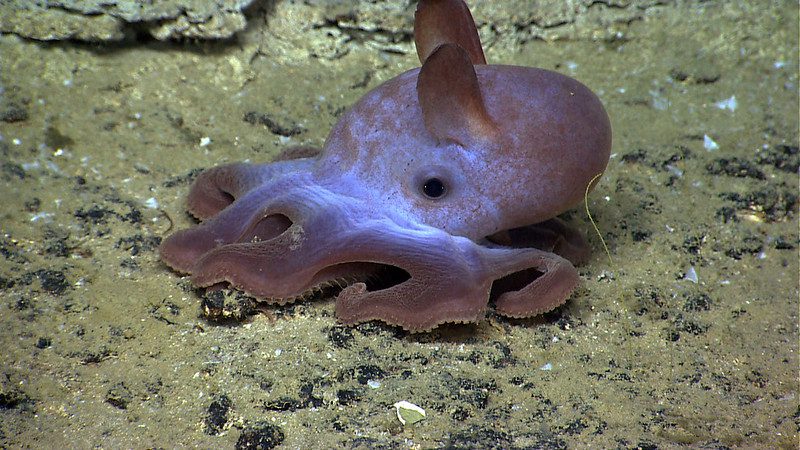
Studying Biology, Geology, and Archaeology Through Ocean Exploration
Nautilus Live is an ocean exploration initiative that aims to study various aspects of the marine environment, including biology, geology, and archaeology. Nautilus Live deploys ROVs with high-definition cameras to capture remarkable footage of the ocean’s depths, including rarely seen creatures like the dumbo octopus and sunken vessels.
This allows them not only to observe elusive species like the dumbo octopus but also to explore shipwrecks and other interesting features on the ocean floor.
Following Along on Social Media for Dive Updates and Photos
To stay up-to-date with Nautilus Live’s latest discoveries and dive updates, you can follow them on various social media platforms such as Facebook, Twitter, or Instagram. These channels provide regular posts featuring breathtaking photos of marine life encounters like those with dumbo octopuses, along with information about ongoing research projects related to understanding our planet’s vast underwater ecosystems.
By observing dumbo octopuses through Nautilus Live’s underwater footage, we can better appreciate these fascinating creatures and their unique behaviors. Their capacity to endure the intense conditions of the depths is a demonstration of nature’s malleability and strength.
By observing Dumbo Octopuses through Nautilus Live, we can gain insight into the unique behaviors of these fascinating creatures. By delving further into their swimming styles and other movements, we can continue to expand our knowledge about them.
Unique Behaviors of the Dumbo Octopus
The dumbo octopus exhibits interesting behaviors that set it apart from other marine species. These captivating creatures have adapted to life in extreme environments deep beneath our planet’s surface waters. By observing their unique actions and movements, researchers can gain valuable insights into how these animals thrive in such challenging conditions.
Sitting Motionless on Seafloor Before Moving Around
One fascinating behavior displayed by the dumbo octopus is its ability to sit motionless on the ocean floor for extended periods before moving around. This strategy allows them to conserve energy while waiting for prey or avoiding predators. When they do decide to move, they use a combination of techniques that make them efficient swimmers despite their seemingly cumbersome appearance.
Swimming Styles Combining Fin Flapping with Arm Pulsation
Dumbo octopuses are known for their distinctive swimming styles, which combine fin flapping and arm pulsation. Their ear-like fins located on either side of their heads allow them to maneuver gracefully through the water like a ballet dancer gliding across a stage:
- Fin Flapping: The primary method used by dumbo octopuses involves flapping their large fins up and down in a rhythmic motion, similar to birds flying through air or fish propelling themselves underwater.
- Arm Pulsation: In addition to using their fins, these cephalopods also employ arm pulsation when needed – this technique resembles jellyfish movement as they contract and expand muscles within each tentacle, simultaneously creating propulsion force.
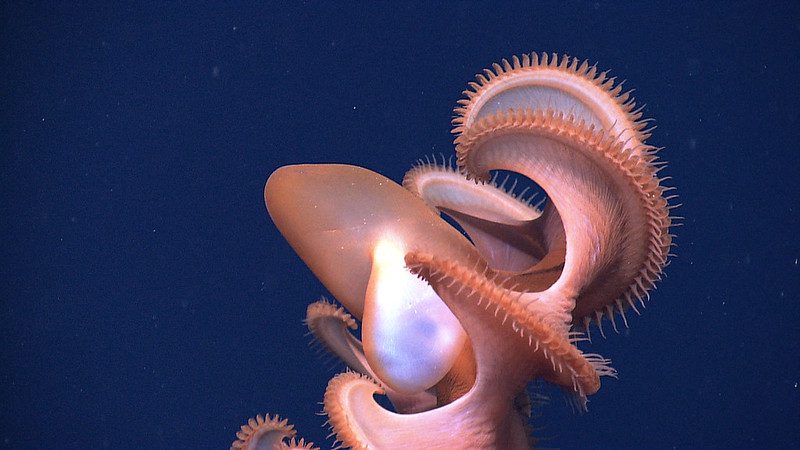
This dual-action approach enables the dumbo octopus not only to navigate efficiently but also to rapidly escape potential threats lurking nearby in dark depths below where sunlight cannot penetrate (National Geographic). Moreover, their aptitude to alter hue and texture adds an extra layer of defense by permitting them to mix in with neighboring surroundings.
By observing the unique behaviors exhibited by dumbo octopuses through Nautilus Live expeditions, researchers can gain a better understanding of these animals’ adaptations and how they contribute to their survival in some of Earth’s most extreme underwater habitats. The more we learn about these fascinating creatures, the more we appreciate the complexity and diversity found within our planet’s oceans.
Key Takeaway:
The dumbo octopus exhibits unique behaviors, such as sitting motionless on the seafloor before moving around and using a combination of fin flapping and arm pulsation for swimming efficiently. These behaviors enable them to thrive in extreme environments deep beneath our planet’s surface waters, providing valuable insights into their adaptations for survival. Through observation of the dumbo octopus, we can expand our knowledge of the vast complexity and variety that exists within Earth’s oceans.
FAQs in Relation to Dumbo Octopus Behavior
What are some behaviors of dumbo octopuses?
The dumbo octopus exhibits several unique behaviors, such as swimming using a combination of fin flapping and arm pulsation. They can also sit motionless on the seafloor before moving around to search for food or avoid predators. Additionally, they have been observed changing color and shape to blend into their surroundings.
What is special about the dumbo octopus?
Dumbo octopuses are known for their distinctive ear-like fins that resemble Disney’s Dumbo character. They live in deep-sea environments up to 4,800 meters below sea level, making them one of the deepest dwelling cephalopods. Their ability to withstand extreme pressure and low temperatures sets them apart from other marine species.
What are three facts about dumbo octopuses?
- Dumbo octopuses belong to the genus Grimpoteuthis, which consists of at least 13 different species.
- They primarily feed on crustaceans, bivalves, worms, and copepods found along the ocean floor.
- Females carry eggs at various stages of development within their bodies until they hatch externally.
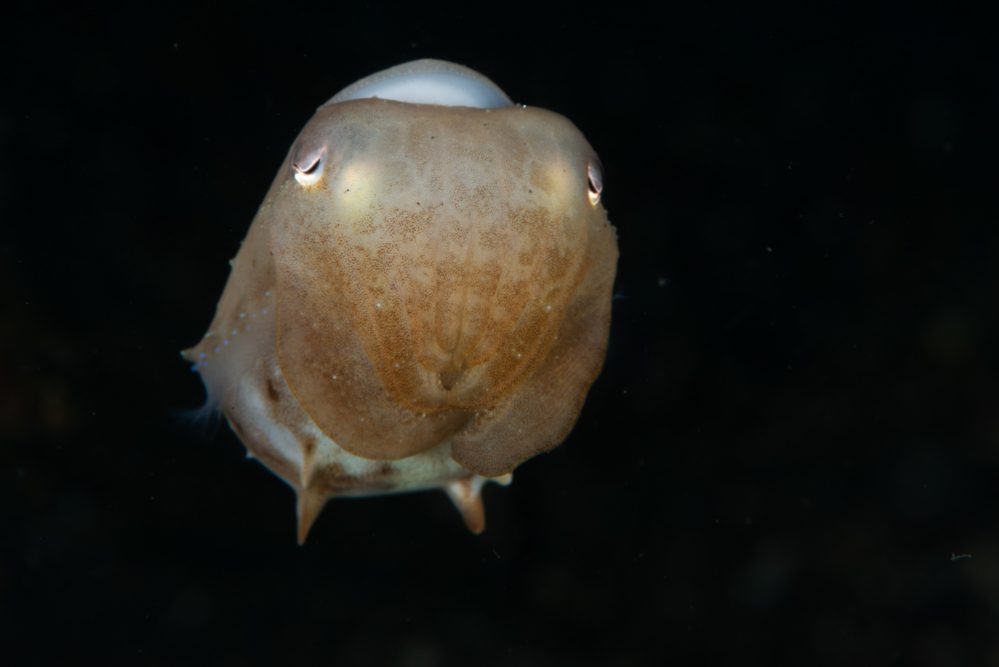
What unusual ability does the dumbo octopus have?
The most unusual ability exhibited by a dumbo octopus is its capacity for instantaneous color change. This adaptive feature allows it to camouflage itself against potential threats or attract prey more effectively in its deep-sea environment. The chromatophores present in its skin enable this remarkable feat. (source)
Conclusion
Their ear-like fins and swimming techniques make them stand out among other octopus species. Observing them through Nautilus Live provides an opportunity to study biology, geology, and archaeology through ocean exploration.







































